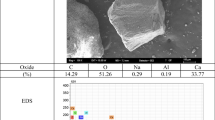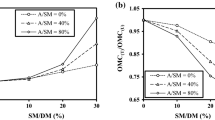Abstract
We evaluated fungal decay and mold resistance, leaching, and water absorption of nano-compounds and Paraloid B72® (PB72) in treated wood specimens to develop new methods of consolidation by combining nano-particles and consolidants. Scots pine wood specimens were treated with dispersions of nano-CuO, nano-ZnO, nano-B2O3, nano-TiO2, and nano-CeO2. PB72 treatments of nano-particle-treated wood specimens were then carried out by either vacuum or immersion for 24 h. Previously, decayed wood specimens were also consolidated with the nano-compounds and PB72. PB72 treatments reduced element release from treated wood specimens. Nearly all nano-compounds + PB72 treatments increased the biological performance of treated wood specimens against decay fungi tested. PB72-only treated wood specimens had the highest weight losses in decay tests. No improvements were obtained in mold resistance tests when the nano-compounds and PB72 were combined. In nano-compound-only treatments, unleached specimens showed slightly lower water absorption values compared to untreated control specimens. Incorporation of PB72 into nano-compound-treated wood specimens resulted in considerably lower water absorption and volumetric swell. In previously decayed specimens treated with the nano-compounds and PB72 solution, water absorption after 2-h immersion declined compared to control specimens.
Similar content being viewed by others
References
Akhtari M, Nicholas D (2013) Evaluation of particulate zinc and copper as wood preservatives for termite control. Eur J Wood Wood Prod 71:395–396
Andres B, Mankowski P (2011) Resistance of lime wood (Tilia sp.) impregnated with Paraloid B-72 resin against cellar fungus Coniophora puteana (Schum., Fr.) Karst. Ann Wars Univ Life Sci SGGW For Wood Technol No 73:94–97
ASTM (2012) American Society for Testing Materials (ASTM). Annual book of ASTM standards, vol. 04, 10. ASTM, West Conshohocken
AWPA (2012) Annual book of AWPA standards. American Wood Preservers Association, Birmingham
Blee A, Matisons JG (2008) Nanoparticles and the conservation of cultural heritage. Mater forum 32:121–128
BS EN (1997) BS EN 113: wood preservatives—test method for determining the protective effectiveness against wood destroying basidiomycetes—determination of the toxic values. No: 1-2, European committee for standardization, Central Secretariat: rue de Stassart 36, B-1050 Brussels. ISBN 0 580 27324 5
BS EN (1997) BS EN 84: wood preservatives, accelerated ageing of treated wood prior to biological testing. Leaching procedure. European committee for standardization, Central Secretariat: rue de Stassart 36, B-1050 Brussels. ISBN 0 580 27639 2
Chen F, Yang X, Wu Q (2009) Antifungal capability of TiO2 coated film on moist wood. Build Environ 44:1088–1093
Christensen M, Kutzke H, Hansen FK (2012) New materials used for the consolidation of archaeological wood-past attempts, present struggles, and future requirements. J Cult Herit 13:183–190
Clausen CA, Green F III, Kartal SN (2010) Weatherability and leach resistance of wood impregnated with nano-zinc oxide. Nanoscale Res Lett 5:1464–1467
Clausen CA, Kartal SN, Arango RA, Green F III (2011) The Role of particle size of particulate nano-zinc oxide wood preservatives on termite mortality and leach resistance. Nanoscale Res Lett 6:427
Clausi M, Crisci GM, Russa MF, Malagodi M, Palermo A, Ruffolo SA (2011) Protective action against fungal growth of two consolidating products applied to wood. J Cult Herit 12:28–33
Cooper PA, Ung TY (2008) Comparison of laboratory and natural exposure leaching of copper from wood treated with three wood preservatives. IRG/WP/08-50258. International Research Group on Wood Protection, Stockholm, Sweden
Filpo G, Palermo AM, Rachiele F (2013) Preventing fungal growth in wood titanium dioxide nanoparticles. Int Biodeterior Biodegrad 85:217–222
Freeman MH, McIntyre CR (2008) Comprehensive review of copper based wood preservatives. For Prod J 58(11):6–27
Green F, Arango RA (2007) Wood protection by commercial silver formulations against Eastern subterranean termites. IRG/WP/07-30422. International Research Group on Wood Protection, Stockholm, Sweden
Henriques DF, Nunes L, Brito J (2010) Performance of Paraloid B72 combined with the application of biocides on wood degraded by fungi. In: Proceedings of 4th international conference on wooden cultural heritage: interaction between wood science and conservation of cultural heritage, COST Action IE0601, Izmir Turkey
JIS (2004) JIS K K 1571: test methods for determining the effectiveness of wood preservatives and their performance requirements. Japanese Standard Association (in Japanese)
Kartal SN, Green F III, Clausen CA (2009) Do unique properties of nanometals affect leachability or efficacy against fungi and termites. Int Biodeterior Biodegred 63:490–495
Lykidis C, Mantanis G, Adamopoulos S, Kalafata K, Arabatzis I (2013) Effects of nano-sized zinc oxide and zinc borate impregnation on brown rot resistance of black pine (Pinus nigra L.) wood. Wood Mater Sci Eng 8:242–244
Mansour MA, Salem MZM (2015) Evaluation of wood treated with some natural extracts and Paraloid B-72 against the fungus Trichoderma harzanium: wood elemental composition, in vitro and application evidence. Int Biodeterior Biodegrad 100:62–69
Mansour MA, Megeed AA, Nasser RA, Salem MZM (2015) Comparative evaluation of some woody tree methanolic mold fungi Alternaria tenuissima and Fusarium culmorum. Biosources, Over-reviewed article 10(2):2570–2584
Mantanis G, Terzi E, Kartal SN, Papadouplos AN (2014) Evaluation of mold, decay and termite resistance of pine wood treated with zinc- and cooper-based nano-compounds. Int Biodeterior Biodegrad 90:140–144
Marzbani P, Mohammadnia-afrouzi Y (2014) Investigation on leaching and decay resistance of wood treated with nano-titanium dioxide. Adv Environ Biol 8(10):974–978
Nakhla SM (1986) A comparative study of resins for the consolidation of wooden objects. Stud Conserv 31:38–44
Németh R, Bak M, Yimmou BM, Csupor K, Molnár S, Csóka L (2012) Nano-zink as an agent against wood destroying fungi. In: Kúdela J, Babiak M (eds) Proceeding of the annual IAWS meeting ‘‘wood the best material for mankind’’ 5th international symposium on the interaction of wood with various forms of energy. International Academy of Wood Science, Technical University, Zvolen, pp 59–63
Olstag TM, Kucerova I (2009) Report of focused meeting within the COST action IE0601. Wood Science for Conservation of Cultural Heritage (WoodCultHer)—consolidation, reinforcement & stabilisation of decorated wooden artefacts. Institute of Chemical Techniques, Prague, Czech Republic
Pohleven F, Valantic A, Petric M (2013) Resistance of consolidated deteriorated wood to wood decay fungi. IRG/WP 13-1081. In: Proceedings IRG 44th annual meeting. ISSN-2000-8953
Soltani M, Najafi A, Yousefian S, Naji HR, Bakar ES (2013) Water repellent effect and dimension stability of beech wood impregnated with nano-zinc oxide, beech with nano-ZnO. Bioresources 8(4):6280–6287
Taghiyari HR, Malek BM, Kookandeh MG (2014) Effects of silver and copper nanoparticles in particleboard to control Trametes versicolor fungus. Int Biodeterior Biodegrad 94:69–72
Traistaru AAT, Campean M, Timar MC (2010) Compatibility indicators in developing consolidation materials with nanoparticle insertions for old wooden objects. Int J Conserv Sci 1(4):219–226 (ISSN: 2067-533X)
Traistaru AAT, Timar MC, Campean M (2011) Studies upon penetration of Paraloid B72 into poplar wood by cold immersion treatments. Bull Transilv Univ Braşov Agricult Food Eng 4(53):81–88
Traistaru AAT, Timar MC, Campean M, Croittoru C, Sandu I (2012) Paraloid B72 Versus Paraloid B72 with nano-ZnO additive as consolidants for wooden artifacts. Mater Plast 49(4):293–300
Traistaru AAT, Sandu ICA, Timar MC, Dumitrescu GL, Sandu I (2013) SEM_EDX, water absorption, and wetting capability studies on evaluation of the influence of nano-Zinc oxide as additive to Paraloid B72 solutions used for wooden artifacts consolidation. Microsc Res Tech 76:208–218
Unger A, Schniewind AP, Unger W (2001) Conservation of wood artifacts a handbook. Springer-Verlag, Germany. ISBN: 978-3-540-41580-0
Acknowledgments
This study was financially supported by the Coordination Unit for Scientific Research of Istanbul University, Turkey (Project No: 45503).
Author information
Authors and Affiliations
Corresponding author
Additional information
Project funding: This study was financially supported by the Coordination Unit for Scientific Research of Istanbul University, Turkey (Project No: 45503).
The online version is available at http://www.springerlink.com.
Corresponding editor: Yu Lei.
Rights and permissions
About this article
Cite this article
Muhcu, D., Terzi, E., Kartal, S.N. et al. Biological performance, water absorption, and swelling of wood treated with nano-particles combined with the application of Paraloid B72® . J. For. Res. 28, 381–394 (2017). https://doi.org/10.1007/s11676-016-0287-1
Received:
Accepted:
Published:
Issue Date:
DOI: https://doi.org/10.1007/s11676-016-0287-1




